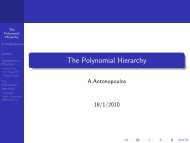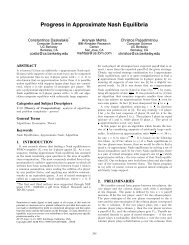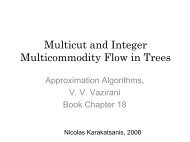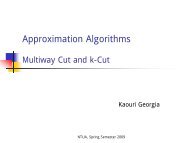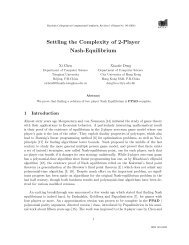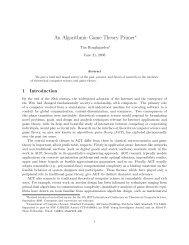The k-center problem - Corelab
The k-center problem - Corelab
The k-center problem - Corelab
You also want an ePaper? Increase the reach of your titles
YUMPU automatically turns print PDFs into web optimized ePapers that Google loves.
<strong>The</strong> k-<strong>center</strong> <strong>problem</strong><br />
Approximation Algorithms 2009<br />
Petros Potikas<br />
NTUA / <strong>Corelab</strong> / Approximation Algorithms / Spring 2009 / P. Potikas / k-<strong>center</strong><br />
1
<strong>The</strong> k-<strong>center</strong> <strong>problem</strong><br />
Definition: Let G=(V,E) be a complete undirected graph with edge<br />
costs satisfying the triangle inequality and k be an integer,<br />
0 < k ≤ |V|. For any S ⊆ V and vertex v ∈ V, define connect(v,S) to<br />
be the cost of the cheapest edge from v to a vertex in S.<br />
Goal: Find a set S ⊆ V, with |S| = k, so as to<br />
minimize max v {connect(v,S)}.<br />
Applications: Place k fire stations or warehouses.<br />
NTUA / <strong>Corelab</strong> / Approximation Algorithms / Spring 2009 / P. Potikas / k-<strong>center</strong><br />
2
<strong>The</strong> k-<strong>center</strong> <strong>problem</strong><br />
Definition: Let G=(V,E) be a complete undirected graph with edge<br />
costs satisfying the triangle inequality and k be an integer,<br />
0 < k ≤ |V|. For any S ⊆ V and vertex v ∈ V, define connect(v,S) to<br />
be the cost of the cheapest edge from v to a vertex in S.<br />
Goal: Find a set S ⊆ V, with |S| = k, so as to<br />
minimize max v {connect(v,S)}.<br />
Applications: Place k fire stations or warehouses.<br />
NTUA / <strong>Corelab</strong> / Approximation Algorithms / Spring 2009 / P. Potikas / k-<strong>center</strong><br />
3
<strong>The</strong> k-<strong>center</strong> <strong>problem</strong><br />
Results<br />
o NP-hard <strong>problem</strong>.<br />
o Approximation algorithm with ratio 2.<br />
o Technique: parametric pruning.<br />
o Generalization to a weighted variant.<br />
NTUA / <strong>Corelab</strong> / Approximation Algorithms / Spring 2009 / P. Potikas / k-<strong>center</strong><br />
4
<strong>The</strong> k-<strong>center</strong> <strong>problem</strong><br />
<strong>The</strong>orem 1: It is NP-hard to approximate the general k-<strong>center</strong> within<br />
factor a(n), for any computable function a(n).<br />
Proof:<br />
Reduction from dominating set…<br />
□<br />
NTUA / <strong>Corelab</strong> / Approximation Algorithms / Spring 2009 / P. Potikas / k-<strong>center</strong><br />
5
Technique: parametric pruning<br />
<strong>The</strong> k-<strong>center</strong> <strong>problem</strong><br />
Idea: prune irrelevant parts of the input<br />
• Suppose OPT = t<br />
• We want a 2-approximation algorithm<br />
• Any edges of cost more than 2⋅t are useless: if two vertices are<br />
connected by such an edge and one of them gets is picked, then the<br />
other vertex is too far away<br />
• We can remove expensive edges<br />
We don’t know OPT, but we guess.<br />
NTUA / <strong>Corelab</strong> / Approximation Algorithms / Spring 2009 / P. Potikas / k-<strong>center</strong><br />
6
Technique: parametric pruning<br />
<strong>The</strong> k-<strong>center</strong> <strong>problem</strong><br />
‣ Order the edges by cost: cost(e 1 ) ≤ cost(e 2 ) ≤ … ≤ cost(e m )<br />
‣ Let G i = (V,E i ), where E i ={e 1 ,…,e i }<br />
‣ <strong>The</strong> k-<strong>center</strong> <strong>problem</strong> is equivalent to finding the minimal index i<br />
such that<br />
G i has a dominating set of size ≤ k<br />
‣ Let i* be this minimal i<br />
‣ <strong>The</strong>n OPT=cost(e i* )<br />
This is still an NP-hard <strong>problem</strong>!<br />
NTUA / <strong>Corelab</strong> / Approximation Algorithms / Spring 2009 / P. Potikas / k-<strong>center</strong><br />
7
<strong>The</strong> k-<strong>center</strong> <strong>problem</strong><br />
Dominating Set: Let H=(U,F) be an undirected graph. A subset S ⊆ U<br />
is a dominating set if every vertex in U – S is adjacent to a vertex in<br />
S.<br />
Goal: Find the minimum dominating set in H.<br />
Dominating Set is NP-hard.<br />
Independent Set: Let H=(U,F) be an undirected graph. A subset S ⊆ U<br />
is an independent set if there is no edge in H having both ends in S.<br />
Maximum Independent Set is NP-hard.<br />
NTUA / <strong>Corelab</strong> / Approximation Algorithms / Spring 2009 / P. Potikas / k-<strong>center</strong><br />
8
<strong>The</strong> k-<strong>center</strong> <strong>problem</strong><br />
Powers of graphs<br />
Let G=(V,E) be a graph. <strong>The</strong> square of G is the graph G 2 =(V,E’), where<br />
(u,v) ∈ E’ if there is a path of length at most 2 between u and v in G<br />
(and u ≠ v).<br />
Generalization: G t G G 2<br />
NTUA / <strong>Corelab</strong> / Approximation Algorithms / Spring 2009 / P. Potikas / k-<strong>center</strong><br />
9
<strong>The</strong> k-<strong>center</strong> <strong>problem</strong><br />
Lemma 1: Given a graph G, let I be an independent set in G 2 .<br />
<strong>The</strong>n, |I| ≤ dom(G).<br />
Proof:<br />
Let D be a minimum dominating set in G (|D|=dom(G)).<br />
<strong>The</strong>n G contains |D| stars spanning all vertices of G ( the vertices<br />
of D are the <strong>center</strong>s of the stars).<br />
A star in G becomes a clique in G 2 .<br />
So G 2 contains |D| cliques spanning all vertices.<br />
Independent set I can pick at most one vertex from each clique.<br />
□<br />
NTUA / <strong>Corelab</strong> / Approximation Algorithms / Spring 2009 / P. Potikas / k-<strong>center</strong><br />
10
Algorithm 1 (Metric k-<strong>center</strong>)<br />
<strong>The</strong> k-<strong>center</strong> <strong>problem</strong><br />
We use that maximal independent sets can be found in polynomial<br />
time.<br />
1. Construct G 1 2 , G 2 2 ,…, G m 2 .<br />
2. Compute a maximal independent set, M i , in each graph G i 2 .<br />
3. Find the smallest index i, such that |M i | ≤ k, say j.<br />
4. Return M j .<br />
NTUA / <strong>Corelab</strong> / Approximation Algorithms / Spring 2009 / P. Potikas / k-<strong>center</strong><br />
11
<strong>The</strong> k-<strong>center</strong> <strong>problem</strong><br />
Lemma 2: For j as defined in the above algorithm, cost(e j ) ≤ OPT.<br />
Proof:<br />
• For i < j, we have that |M i | > k.<br />
• By Lemma 1, dom(G i ) > k.<br />
• So, i* > i.<br />
Thus, j ≤ i*.<br />
□<br />
NTUA / <strong>Corelab</strong> / Approximation Algorithms / Spring 2009 / P. Potikas / k-<strong>center</strong><br />
12
<strong>The</strong> k-<strong>center</strong> <strong>problem</strong><br />
<strong>The</strong>orem 2: Algorithm metric k-<strong>center</strong> achieves an approximation<br />
factor 2.<br />
Proof:<br />
• Any maximal independent set I in G j 2 is also a dominating set<br />
(for, if some vertex u is not dominated by I, then I∪{u} is an<br />
independent set, contradicting I’s maximality).<br />
• In G j 2 we have |M j | stars <strong>center</strong>ed on the vertices in M j .<br />
• <strong>The</strong>se stars cover all the vertices.<br />
• Each edge used in constructing these stars has cost at most<br />
2⋅cost(e j ) ≤ 2⋅OPT (by Lemma 2).<br />
□<br />
NTUA / <strong>Corelab</strong> / Approximation Algorithms / Spring 2009 / P. Potikas / k-<strong>center</strong><br />
13
<strong>The</strong> k-<strong>center</strong> <strong>problem</strong><br />
Tight example:<br />
.<br />
…<br />
n+1 vertices<br />
thick edges have cost 1, all edges incident to the <strong>center</strong><br />
thin edges have cost 2, the rest of the edges (not all edges of cost 2 are<br />
shown)<br />
For k = 1, OPT = 1, the <strong>center</strong> of the wheel<br />
<strong>The</strong> algorithm will compute j=n, G n2 is a clique, and if a peripheral<br />
vertex is chosen, then cost is 2.<br />
NTUA / <strong>Corelab</strong> / Approximation Algorithms / Spring 2009 / P. Potikas / k-<strong>center</strong><br />
14
<strong>The</strong> k-<strong>center</strong> <strong>problem</strong><br />
<strong>The</strong>orem 3: If P ≠ NP, no approximation algorithm gives a<br />
(2-ε)-approximation for ε>0.<br />
Proof:<br />
Reduction from dominating set to the metric k-<strong>center</strong> <strong>problem</strong>.<br />
Let G = (V,E), k be an instance of the dominating set <strong>problem</strong>.<br />
We define the complete graph G’ = (V,E’), where<br />
cost(u,v)=1, if (u,v) ∈ E<br />
cost(u,v)=2, if (u,v)∉ E<br />
G’ satisfies the triangle inequality.<br />
NTUA / <strong>Corelab</strong> / Approximation Algorithms / Spring 2009 / P. Potikas / k-<strong>center</strong><br />
15
<strong>The</strong> k-<strong>center</strong> <strong>problem</strong><br />
<strong>The</strong>orem 3: If P ≠ NP, no approximation algorithm gives a<br />
(2-ε)-approximation for ε>0.<br />
Proof(cont’d):<br />
Suppose G has a dominating set of size at most k.<br />
<strong>The</strong>n G’ has a k-<strong>center</strong> of cost 1<br />
→a (2-ε)-approximation algorithm delivers one with cost < 2.<br />
If there is no such dominating set in G, every k-<strong>center</strong> has<br />
cost ≥ 2 > 2-ε.<br />
Thus, a (2-ε)-approximation algorithm for the k-<strong>center</strong> <strong>problem</strong> can be<br />
used to determine whether or not there is a dominating set of size k. □<br />
NTUA / <strong>Corelab</strong> / Approximation Algorithms / Spring 2009 / P. Potikas / k-<strong>center</strong><br />
16
<strong>The</strong> weighted k-<strong>center</strong> <strong>problem</strong><br />
Definition: Let G=(V,E) be a complete undirected graph with edge<br />
costs satisfying the triangle inequality, with weights on vertices and<br />
a bound W ∈ R + . For any S ⊆ V and vertex v ∈ V, define<br />
connect(v,S) to be the cost of the cheapest edge from v to a vertex in<br />
S.<br />
Goal: Find a set S ⊆ V, with total weight at most W, so as to minimize<br />
max v {connect(v,S)}.<br />
Applications: Place fire stations or warehouses, given a budget.<br />
NTUA / <strong>Corelab</strong> / Approximation Algorithms / Spring 2009 / P. Potikas / k-<strong>center</strong><br />
17
<strong>The</strong> weighted k-<strong>center</strong> <strong>problem</strong><br />
‣ We use the same graphs G 1 , G 2 , …,G m<br />
‣ Let wdom(G) be the weight of a minimum weight dominating set in<br />
G<br />
‣ Find the minimal index i such that<br />
wdom(G i ) ≤ W<br />
‣ Let i* be this minimal i<br />
‣ <strong>The</strong>n OPT=cost(e i* )<br />
NTUA / <strong>Corelab</strong> / Approximation Algorithms / Spring 2009 / P. Potikas / k-<strong>center</strong><br />
18
<strong>The</strong> weighted k-<strong>center</strong> <strong>problem</strong><br />
• Let I be an independent set in G 2<br />
• For any vertex u, let s(u) denote its lightest neighbor of u<br />
• We also consider u to be a neighbor of itself<br />
• Let S={s(u) | u ∈ I}<br />
• We claim w(S) ≤ wdom(G)<br />
NTUA / <strong>Corelab</strong> / Approximation Algorithms / Spring 2009 / P. Potikas / k-<strong>center</strong><br />
19
<strong>The</strong> weighted k-<strong>center</strong> <strong>problem</strong><br />
Lemma 3: w(S) ≤ wdom(G)<br />
Proof:<br />
Let D be a minimum weight dominating set in G (w(D)=wdom(G)).<br />
<strong>The</strong>n G contains |D| stars spanning all vertices of G (the vertices<br />
of D are the <strong>center</strong>s of the stars).<br />
A star in G becomes a clique in G 2 .<br />
So G 2 contains |D| cliques spanning all vertices.<br />
Independent set I can pick at most one vertex from each clique.<br />
Each vertex in I has the <strong>center</strong> of the corresponding star available<br />
as a neighbor in G (this might not be the lightest neighbor).<br />
Thus, w(S) ≤ wdom(G).<br />
□<br />
NTUA / <strong>Corelab</strong> / Approximation Algorithms / Spring 2009 / P. Potikas / k-<strong>center</strong><br />
20
<strong>The</strong> weighted k-<strong>center</strong> <strong>problem</strong><br />
Algorithm 2 (Weighted k-<strong>center</strong>)<br />
Let s i (u) denote the lightest neighbor of u in G i .<br />
1. Construct G 1 2 , G 2 2 ,…, G m<br />
2<br />
2. Compute a maximal independent set, M i , in each graph G i<br />
2<br />
3. Compute S i = {s i (u) | u∈ M i }<br />
4. Find the smallest index i, such that w(S i ) ≤ W, say j<br />
5. Return S j<br />
NTUA / <strong>Corelab</strong> / Approximation Algorithms / Spring 2009 / P. Potikas / k-<strong>center</strong><br />
21
<strong>The</strong> weighted k-<strong>center</strong> <strong>problem</strong><br />
<strong>The</strong>orem 2: This algorithm achieves a 3-approximation.<br />
Proof:<br />
OPT ≥ cost(e j ) (as Lemma 2)<br />
M j is a dominating set in G j<br />
2<br />
We can cover V with stars of G j 2 <strong>center</strong>ed in vertices of M j<br />
<strong>The</strong>se stars use edges of cost at most 2⋅cost(e j )<br />
NTUA / <strong>Corelab</strong> / Approximation Algorithms / Spring 2009 / P. Potikas / k-<strong>center</strong><br />
22
<strong>The</strong> weighted k-<strong>center</strong> <strong>problem</strong><br />
<strong>The</strong>orem 2: This algorithm achieves a 3-approximation.<br />
Proof (cont’d):<br />
Each star <strong>center</strong> is adjacent to a vertex in S j , using an edge of cost at<br />
most cost(e j )<br />
Move each <strong>center</strong> of these stars to the adjacent vertex in S j and redefine<br />
the star<br />
Every vertex in G j , can be reached by a cost at most 3⋅cost(e j )<br />
□<br />
NTUA / <strong>Corelab</strong> / Approximation Algorithms / Spring 2009 / P. Potikas / k-<strong>center</strong><br />
23
<strong>The</strong> weighted k-<strong>center</strong> <strong>problem</strong><br />
Tight example:<br />
∞<br />
∞<br />
…<br />
∞<br />
1+ε<br />
1+ε<br />
1+ε<br />
a<br />
1<br />
b<br />
1<br />
c<br />
1<br />
d<br />
1 2 2 2<br />
n+4 vertices, W=3<br />
All edges not shown have cost equal to the cost of the shortest path in the<br />
graph shown.<br />
OPT = 1+ε ({a,c})<br />
For any i
<strong>The</strong> k-<strong>center</strong> <strong>problem</strong><br />
Related <strong>problem</strong><br />
Metric k-cluster: Let G=(V,E) be a complete undirected graph with<br />
edge costs satisfying the triangle inequality and k be an integer,<br />
0 < k ≤ |V|.<br />
Goal: Partition V into sets V 1 ,V 2 ,…,V k , so as to minimize the costliest<br />
edge between two vertices in the same set, i.e. minimize<br />
max 1≤i≤k u,v∈Vi cost(u,v)<br />
NTUA / <strong>Corelab</strong> / Approximation Algorithms / Spring 2009 / P. Potikas / k-<strong>center</strong><br />
25



